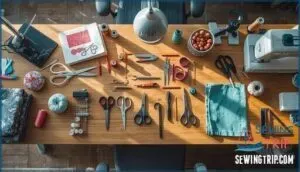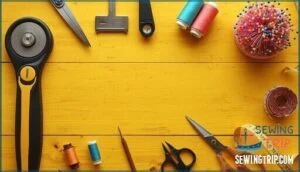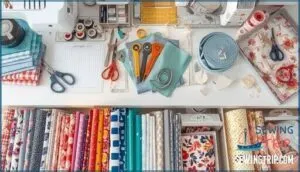This site is supported by our readers. We may earn a commission, at no cost to you, if you purchase through links.

Sewing is equal parts creativity and problem-solving, but it’s the time you wrestle from the margins that transforms frustration into flow. With practical sewing project tips and smart time management, you’ll reclaim control, sew smarter, and see your best ideas stitched into reality.
Table Of Contents
- Key Takeaways
- Planning and Scheduling Your Sewing Projects
- Organizing Your Sewing Space for Efficiency
- Essential Tools to Save Time
- Streamlined Cutting and Preparation Techniques
- Smart Sewing and Assembly Strategies
- Building Consistent and Productive Sewing Habits
- Frequently Asked Questions (FAQs)
- Conclusion
Key Takeaways
- Breaking big sewing projects into smaller, manageable tasks keeps you productive and helps prevent overwhelm.
- Staying organized—both in your sewing space and with project tracking—makes it easier to start, work, and finish strong.
- Investing in the right tools, like quality scissors and good lighting, saves time and improves your results.
- Building habits like setting clear goals, working in short focused sessions, and celebrating progress keeps your motivation high and projects on track.
Planning and Scheduling Your Sewing Projects
Getting organized before you sew makes every project less stressful. With a clear plan and a bit of structure, you’ll finish more and enjoy the process from start to finish.
Here’s how you can set yourself up for success.
Setting Realistic Sewing Goals
Real progress starts with honest goal reflection. When you set SMART sewing goals—think specific, measurable, and time-bound—you’ll avoid burnout and see real wins.
Plan seasonal projects and stick to achievable sewing goals, like finishing two garments per quarter. Tracking systems, such as a visual journal or digital log, keep your project goals visible and time management on track.
Joining a sewing community helps provide support and motivation.
Breaking Projects Into Manageable Tasks
Splitting a project into clear, bite-sized chunks makes your work feel lighter and more enjoyable. Try workflow mapping—writing out project steps—to shrink cognitive load. Batch similar tasks or use the Pomodoro Technique for focused bursts. Incremental progress stacks up quickly, and you’ll notice better time management, less frustration, and task management that keeps each subtask moving toward your finish line.
If you’re feeling stuck, consider that creative ruts happen to everyone.
Creating a Project Timeline or Tracker
Once you’ve broken projects into steps, use Timeline Visualization and Digital Trackers to make progress tangible. Mark up project steps, then keep momentum by recording what’s complete.
For an efficient project workflow, try this:
- List and sequence tasks
- Estimate completion dates
- Track time spent
- Audit and adjust as needed
This habit builds accountability and continuous adjustment into your sewing routine.
Prioritizing Projects for Maximum Impact
Once you can see your project timeline at a glance, it’s time to weigh priorities. Ask yourself: Which sewing projects carry the greatest Project Value—whether that’s learning a new skill or finally using the fabric that’s been waiting?
Match Time Commitment and Skill Level with your week ahead. Putting Personal Interest atop your project planning can spark momentum and boost your efficient project workflow.
Organizing Your Sewing Space for Efficiency
A well-organized sewing space makes every project feel a little lighter. When your tools and supplies have a home, it’s easier to get started and stay focused.
Here are a few practical ways to create a workspace that aids your best sewing.
Designating a Dedicated Sewing Area
Ever notice how much smoother things run when your sewing space isn’t just “the corner of a table”? Claim your own spot—a dedicated sewing area—where efficiency and focus flourish. Reap these rewards:
- Ergonomic workstation setup reduces aches.
- Smart space optimization minimizes mess.
- Safer, brighter environments—thanks to proper lighting standards and storage integration—keep your creativity moving.
Keeping Tools and Materials Within Reach
With an ergonomic layout, keeping tools within reach is a major advantage for workflow optimization. Place sewing tools—scissors, pins, rulers—within 0.6 meters to cut down on wasted motion. Thoughtful tool organization improves speed but also helps maintain your momentum.
Tech integration, like digital trackers, can spotlight bottlenecks, while smart maintenance practices help your workspace—and your productivity—stay sharp.
Using Storage Solutions for Supplies
With clear containers, you’ll know exactly where your notions are—no more digging. Vertical shelving frees up workspace, keeping fabric and supplies visible and neat. Modular furniture adapts as your stash grows, while fabric filing systems prevent wrinkles.
DIY organizers and labeled bins turn chaos into an organized workspace, supporting your tool organization and streamlining every step of your sewing projects.
Optimizing Lighting for Accuracy
Stitching under dim lights is like painting with a muddy brush—you’re bound to miss details. Lumens and Lux matter; aim for LED technology with adjustable color temperature and high CRI for true color matching.
Try layered lighting: overhead, focused task, and accent lights. Good lighting accuracy means fewer errors, greater sewing efficiency, and an organized workspace you’ll actually want to use.
Essential Tools to Save Time
Having the right tools at your fingertips makes every sewing project smoother and quicker. When you choose wisely, even small upgrades can shave minutes off your routine.
Here’s what should be on your worktable if you’re serious about saving time.
Choosing Quality Scissors and Shears
Choosing quality scissors and shears isn’t just about splurging—it’s about working smarter. Sharp fabric scissors glide through layers like butter, thanks to excellent blade material and edge retention. Look for ergonomic design to protect your hands, and check brand benchmarks for proven performance. Stainless steel and titanium coatings add corrosion resistance, so your favorite cutting tools stay sharp and reliable.
- Select high-carbon or stainless blades for lasting sharpness.
- Prioritize ergonomic design for comfortable, fatigue-free cutting.
- Research brand benchmarks for trusted fabric shears.
- Choose corrosion-resistant finishes for tool longevity.
Maintaining Sharp Needles and Tools
There’s nothing subtle about the impact of sharp needles and tools on your results—think of them as your sewing superpower. Replace machine needles every 6–10 hours; test sharpness before starting; and don’t underestimate a quick polish or proper storage.
Whether you’re working with delicate fabrics or sturdy denim, quality tools and routine care keep your sewing efficiency high.
Investing in a Rotary Cutter and Cutting Mat
When you want to cut fabric efficiently, few tools beat a rotary cutter paired with a cutting mat. This combo isn’t just fast—it pays off:
- Blade sharpness means smoother edges
- Cutting accuracy goes up, mistakes drop
- Ergonomic benefits reduce hand fatigue
- Mat maintenance boosts tool life
- Cost savings stack up with less waste
Invest once, save every time.
Using Seam Rippers for Quick Fixes
After cutting with precision, mistakes still sneak in. That’s where mastering seam ripping techniques comes to the rescue—using a seam ripper isn’t defeat, but smart seam repair.
Prioritize ripping ergonomics for comfort during repeated fixes, and choose ripper styles that offer fabric protection or suit delicate fabrics.
For speedy seam removal, keep automation in mind—especially for tougher jobs.
Streamlined Cutting and Preparation Techniques
Getting started right can save you hours down the line and spare you plenty of frustration. Let’s look at a few cutting and prep habits that make all the difference before you ever sit down to sew. Here’s what to focus on first.
Pre-Washing and Pressing Fabrics
Before you even get out your fabric shears, take time for a proper prewash and pressing routine. Pre-washing is essential for shrinkage prevention, dye removal, and grain stabilization—no one likes surprises mid-project.
Pressing fabrics after drying flattens fibers for accurate cuts and neat seams. This smart fabric preparation boosts workflow impact, ensures care compliance, and makes fabric storage a breeze.
Accurate Measuring and Marking
Once your fabric’s pressed, measuring and marking make or break fit and confidence. For consistent results:
- Double-check measuring tools before use.
- Mark grainlines early for accurate alignment.
- Use sharp marking tools with controlled pressure.
- Confirm pattern points and seam allowances twice.
- Cross-check measurements at each step—catches tiny errors.
A precise start always makes cutting fabric accurately every time a reality.
Efficient Fabric Cutting Methods
If you’re after sharp efficiency, choosing the right cutting tool matters just as much as a steady hand. Straight Knife cutting powers through thick stacks swiftly, while Laser Cutting or Water Jet tools tame fine details beautifully. Ultrasonic Cutters seal and slice synthetics in one motion. Automated Systems, though, transform fabric cutting from a chore into clockwork—each method keeps your projects on track.
Batching Cutting Tasks for Multiple Projects
Momentum builds when you employ Batching Strategies: stack and slice several projects’ fabrics in one session. Cutting Optimization goes beyond neat piles—group by fabric type and prep your cutting tools in advance.
These Productivity Tips boost efficiency gains, with batching sewing tasks reducing fabric preparation and swap time. Mastering these cutting techniques means slicing sewing time while elevating your overall Fabric Management game.
Smart Sewing and Assembly Strategies
Once you’ve handled your prep, it’s time to make each stitch count. There are a few clever ways to keep your sewing and assembly on track.
Here’s how you can stay focused and work more efficiently as you sew.
Batching Similar Sewing Steps
Ever notice how efficiency techniques in sewing can feel like lining up dominoes—one tip sets the others in motion? Batching sewing tasks, or grouping similar steps together, is a true timesaving sewing technique.
Sequential sewing and batch scheduling cut down backtracking, simplify workflow optimization, and transform fabric batching into a habit that shrinks your sewing time and keeps your workspace wonderfully organized.
Using Basting Spray and Adhesives
Why spend hours bent over pins when modern basting techniques can have your quilt layered and stable in under half an hour?
Basting spray streamlines assembly, taking the mess and guesswork out of fabric bonding. Safe, repositionable adhesives—formulated for minimal residue—let you achieve smooth, pucker-free results, making spray efficiency a genuine breakthrough for timesaving sewing techniques.
Mastering Core Machine Features
Why settle for frustration when your sewing machine can be your co-pilot? Explore features like automatic threading, adjustable speed controls, and a toolkit of presser feet to fine-tune every stitch. Mastering stitch selection and taking full advantage of built-in LED lighting won’t just brighten your workspace—it will transform your sewing techniques and save real time.
- Automatic Threading eliminates wasted time and reduces eye strain.
- Speed Controls allow you to adjust for tricky fabrics or fast seams.
- Specialized Presser Feet help you tackle unique sewing tasks with confidence.
- Digital Stitch Selection enhances accuracy and creativity with every project.
- Integrated LED Lighting keeps your work area bright, cutting down on mistakes.
Pressing Seams as You Go
Pressing seams as you sew is like giving each stitch a head start. Seam pressing isn’t just about looking neat—it sets stitches, sharpens seam allowances, and streamlines garment construction right from the start.
Ironing techniques matter: a quick press with steam flattens fabric layers, saves time on rework, and brings your garment finishing one step closer to professional quality.
Building Consistent and Productive Sewing Habits
Developing strong sewing habits is how you turn good intentions into finished projects. Let’s look at the strategies that help you stay focused and make steady progress.
Here are a few simple habits that can boost your productivity.
Scheduling Short, Regular Sewing Sessions
Frequently, a Daily Sewing Routine built around short, focused sewing sessions—think Time Blocking or quick Sewing Sprints—can work wonders for managing time effectively.
Scheduling Micro Sessions, like 30- to 60-minute sewing sessions, keeps your energy high and progress steady.
It’s a straightforward Productivity Hack; smaller chunks consistently outshine marathons in the realm of time management for sewists.
Minimizing Distractions and Interruptions
Even a solid sewing routine falls apart when interruptions sneak in. Try a quick Digital Detox—phones silenced, notifications off. Use Focus Modes or a “Don’t Disturb” sign for clear Household Boundaries.
Keep tools within reach and outline your next steps on paper. Mindful Sewing paired with Task Segmentation helps you quiet distractions and master time management for sewists.
Taking Strategic Breaks to Maintain Focus
Once distractions are tamed, Break Timing becomes your secret weapon for Focus Enhancement. Build Mindful Pauses into your sewing session framework—just five to ten minutes away from the machine can offer a real Productivity Boost. Rest Strategies aren’t wasted time; they’re time management tips in disguise. Try these quick breaks:
- Stand and stretch
- Savor a drink
- Sketch design ideas
- Listen to a favorite song
Tracking Progress and Celebrating Milestones
Just like a good pause fuels your next stitch, tracking progress brings momentum to your sewing journey. Jotting notes in Sewing Journals, breaking projects into manageable metrics, and celebrating with Achievement Rewards keeps motivation sky-high.
Try these tools and strategies:
| Progress Tracking | Achievement Rewards |
|---|---|
| Sewing Journals | Treat Yourself |
| Goal Setting | Share Progress |
| Achievement Metrics | New Project Ideas |
Frequently Asked Questions (FAQs)
How can I avoid sewing project burnout?
Nearly 70% of creative professionals face burnout from workspace stress and unclear goals.
To dodge the sewing slump, embrace goal clarity, task batching, habit building, and strategic breaks—your blueprint for better work-life balance, self-care, and mental wellness.
Prevent sewing burnout by building habits, setting clear goals, batching tasks, and taking regular breaks for balance and well-being
What’s the best way to handle unexpected mistakes?
When sewing challenges pop up—like a skipped stitch, thread breaks, or uneven seams—pause, analyze the error, reach for a seam ripper if needed, apply targeted correction techniques, and jot notes to prevent recurrence. Reflect, don’t rush.
How do I maintain motivation for long-term projects?
When motivation unravels, stitch progress together with clear goal setting, task decomposition, and consistent habits.
Celebrate milestones, control your environment, and connect with your intrinsic drive—these strategies keep your sewing goals strong, even on marathon projects.
What are quick ways to clean up after sewing?
Keep your sewing space tidy by pre-sorting scraps for fabric recycling and using scrap bins and automated waste systems for quick cleanup.
Store tools in labeled containers and brush work surfaces with a lint roller for instant surface lint removal.
How can I balance sewing with other daily priorities?
Slipping sewing into your daily routine doesn’t require heroic effort—time blocking works wonders, and a flexible schedule allows for guilt-free sewing.
Embrace short sessions, avoid multitasking myths, and invite family involvement to boost sewing time alongside priorities.
Conclusion
Every sewing room faces its share of “creative disarray”—think of it as fabric confetti, not chaos. But when you apply these sewing project tips for time management, what once felt overwhelming starts to feel manageable—even enjoyable.
You’ll spot the method in the madness, finding the rhythm that turns busy hands into finished projects. Each stitch moves you forward, revealing that control isn’t about having extra time, but making the time you have count. Now, go stitch your story.
- https://laccei.org/LACCEI2023-BuenosAires/papers/Contribution_1051_a.pdf
- https://www.construction-institute.org/craft-productivity-research-program-phase-ii
- https://www.blossomheartquilts.com/2020/10/how-to-find-time-for-sewing/
- https://www.reddit.com/r/sewhelp/comments/khpfur/what_are_sewing_best_practices_that_shouldnt_be/
- https://howtomakewreaths.com/plan-production-with-craft-calendar/














